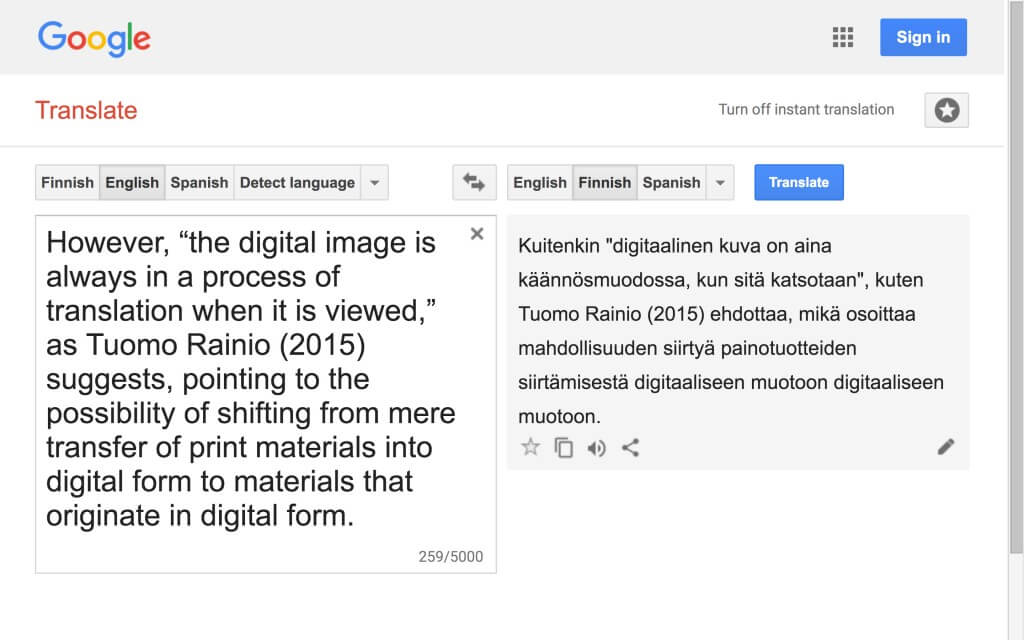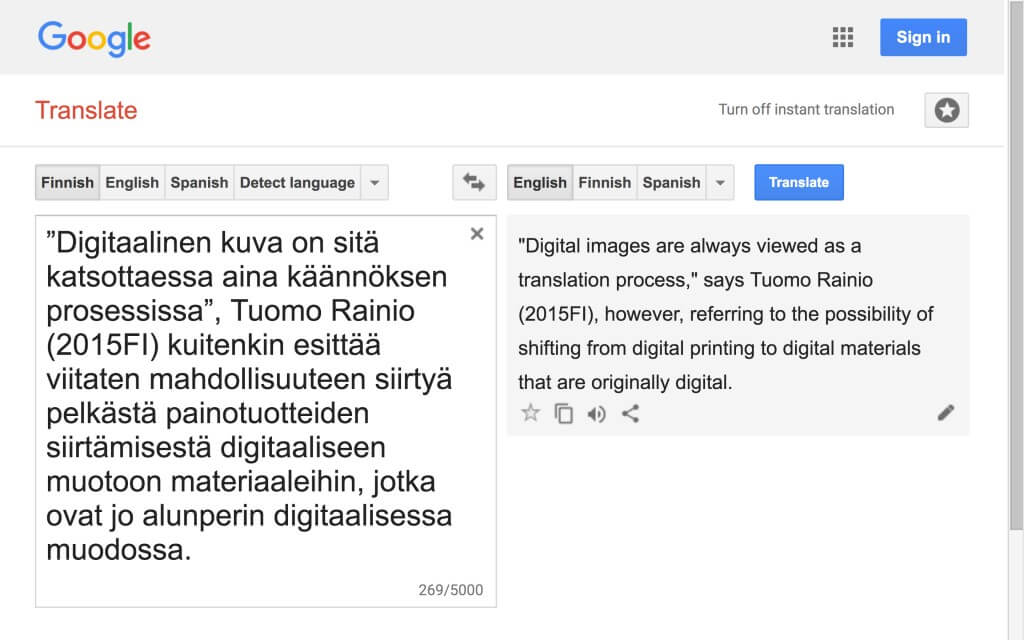3.2 Fragment 22
- Fragment 22, adapted from Hayles passage 18
As the most important aspect of fragment 22, I want to underscore a fact that might escape the reader-viewer not in possession of a copy of How We Think. Getting into the later stages of DAR’s adaptation, there seems to be increased pressure to accelerate the reading-writing process on display in order to reach a goal or conclusion. However, in the case of such a systematic work, the danger is that the acceleration will lead to losing the so-called common thread, which in this case comprises not only the issues arising in relation to Hayles but also the way they are brought up.
I note this because what I find when I consult Hayles’s book is striking. Fragment 22 is a significant turn in DAR’s adaptation in that it marks the first time they deviate from following the linear progression of Hayles’s book. More concretely, it is the first time they do not adapt the sentence (or several sentences) immediately following the previously adapted sentence(s). In fragment 21, DAR adapts a passage that appears on page three of Hayles’s book. In fragment 22, however, they have jumped to a passage that can be found on page four.
Up until now, DAR has adapted each and every sentence in the first three and a half pages of How We Think. How are we to understand that they now decide to omit a section in which Hayles discusses, among other things, the relationship of print and digital publishing and the advantages of the latter over the former (Hayles 2012, 3–4)? Is this relationship—or what Hayles has to say about it here—not relevant for DAR’s thesis? Or has it, in their judgment, already been dealt with sufficiently in the previous fragments?
More importantly, does this anticipate an overall change in DAR’s approach to Hayles that will transform the remainder of their work? The sudden gesture strikes me as almost wild or violent, especially with regard to how methodical and disciplined DAR has been thus far (at least in following the manner in which they have chosen to adapt). Is this just an exception that reinforces the rule? Or is there a more down-to-earth explanation, for example that DAR is simply getting tired of adhering to such an unyielding adaptation regime?
Internal Contradictions
For the answers to these questions, we will have to wait for the remaining fragments of DAR’s adaptation. In the meantime, I will focus on the surface or immediate appearances of fragment 22. In it, DAR arrives at a destination they have worked hard to reach: born digital artistic research (3.2EN1). However, my reading is complicated by an internal contradiction in the fragment, whose first part does not seem to connect in any logical manner with its second part. In the first part, DAR cites the English abstract to Tuomo Rainio’s research exposition “Reconfigured Image—translations between concept, code and screen” (Rainio 2015) (see 1.4).
In the passage, Rainio writes about the relationship of the screen and its viewer in terms of translation. He suggests that digital objects are in a state of perpetual change, as they are dependent on their translator, the computer that displays them. As interesting as this insight is, I fail to understand how it relates to the second part of the sentence, in which DAR turns to speak of “shifting from mere transfer of print materials into digital form to materials that originate in digital form” (see fragment 22).
It is as if DAR were pointing in one direction, towards translation, with the first part of the sentence, and in another, towards born digital research, with the second. Semantically, the two parts do not come together in the way the structure of the sentence would suggest. Since translation is dealt with in the following fragments, I will touch on the latter part of the sentence, which relates more directly to this study. Also, the second part relates more closely to the aforementioned Hayles passage that fragment 22 seeks to adapt (see adapted from Hayles passage 18).
Digital Native or Immigrant
Hayles writes of researchers’ deepening commitment to digital media, an engagement that ultimately leads to them becoming sites of research. This, for me, is the issue DAR has been getting at for some time now. More specifically, DAR would like to draw our attention to the fact that this thesis, unlike love.abz/(love.abz)3, meets the criteria of a born digital work: like Rainio’s exposition, it is created in and viewed through digital media.
For DAR, this is the crucial difference between the artistic parts of the research and the written part. In love.abz/(love.abz)3, human performers situated in a physical performance space interact with digital media, which is why the performances cannot be considered born digital. As I note in 2.8, the artistic parts have instead two main stages: the physical performance space where the performers produce improvised speech, and the digital or virtual space, in which this speech is modified into text appearing on multiple screens.
This thesis, on the other hand, is exclusively created in a digital space, at least if we follow DAR’s logic. In the creation of this work, I use word processing, algorithmic translation, and many other digital technologies. Apart from occasional printouts of some parts of this work, it lacks any kind of physical manifestation (3.2EN2). For DAR, this is an indication of the deepening relationship Hayles describes, which takes the engagement between researcher and digital media to another, more desirable level (Hayles 2012, 4).
Born Digital
Thus far, I have tried to interpret fragment 22 in accordance with the surface reading ethos discussed in 1.12, without looking for symptoms of subsurface ideological statements. However, I cannot but point out that “born digital” is, in itself, a symptomatic term that raises a number of knotty ontological and, unavoidably, ideological questions. What, in fact, does it mean that something is “born digital”? Or, in other words, how digital must the object be in order to be born digital?
To continue to use this thesis as an example, one could ask what happens when it is printed and edited in print form (as occasionally occurs over the course of writing it). Does it then cease to be born digital? Or is its born digital status compromised? If the requirements of digital nativity are further extended, it is necessary to ask whether thinking too should be born digital, in which case only products of artificial intelligence could fully meet the criteria.
The purpose of these questions, the outcomes of my admittedly symptomatic reading, is not to ridicule DAR’s (and Hayles’s) desire to emphasize the importance of digital media in meaning-making processes. Rather, I wish to remind that even if the end products of this work can only be viewed in digital form, its production is still the result of complex cognitive processes. As discussed in 2.7 and 2.8, depending on how we understand cognition, in this case it can be considered to occur in my head, my body, and/or in the wider cognitive system, parts of which my computer and the other cognitive tools of my environment are.
Since the psychophysical and social whole that I am is still (at least) part of the process, it is misleading to consider the work I am creating purely digital. Exclusively born digital artistic research would have to be carried out by robots and for robots, although even then the question of human (sub)agency would remain. How do we account for the humans that are needed to equip the robots with the algorithms they need to produce results that are similar to the results of mental processes? The key question for this research is, if this written part can indeed, in some sense, be regarded as born digital, what added value or insight does this bring to the project as a whole.
Notes
3.2EN1
The term born-digital “denotes texts or recordings produced in digital form, rather than having been converted from print or analog equivalents” (New Oxford American Dictionary).
3.2EN2
Unless, of course, we take into account the physical infrastructure needed to maintain and run this website. For more on the physical infrastructure of the Internet, see Blum 2012.

